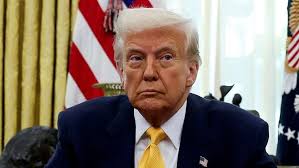
President Donald Trump’s economic approval rating has reached its lowest point since he took office, marking the first time it has slipped into negative territory in any CNBC poll. This downturn reflects growing public dissatisfaction with his administration's handling of key economic issues.
The decline is particularly notable given the initial optimism that followed Trump's re-election. However, recent economic challenges, including inflation and trade tensions, have eroded public confidence in his economic leadership.
The partisan divide over Trump's economic policies has intensified. Democrats have registered a historic –90 net economic approval, while independents are 23 points more negative than during his first term. This polarization suggests that Trump's economic strategies are failing to resonate beyond his core base, potentially complicating efforts to build broader support for his policies.
Erosion Among Blue-Collar Workers
Blue-collar workers, once a reliable support base for Trump, have shown increasing disapproval of his economic handling. Disapproval among this group has risen by 14 points compared to his first term. This shift indicates that economic policies perceived as unfavorable to working-class interests are diminishing support among a key demographic that was instrumental in Trump's electoral success.
A significant majority of Americans, 57%, now believe the U.S. is in—or headed for—a recession, a sharp increase from 40% just a year ago. This growing pessimism reflects widespread concern about the nation's economic trajectory. The anticipation of a recession is further fueled by factors such as persistent inflation, rising interest rates, and global economic uncertainties, which collectively undermine consumer and investor confidence.
Tariff Policies Under Scrutiny
Disapproval of Trump's tariff policies has emerged as a key driver of negative sentiment. Approximately 49% of Americans view across-the-board levies as harmful to workers and inflation. Critics argue that these tariffs disrupt supply chains and increase costs for consumers and businesses, contributing to inflationary pressures and economic instability.
Inflation handling is identified as Trump's weakest issue, with only 37% approval and two-thirds of the public expressing dissatisfaction. The rising cost of living has become a central concern for many Americans. Persistent inflation erodes purchasing power and can lead to decreased consumer spending, further slowing economic growth and exacerbating public discontent.
Stock market pessimism has surged, with 53% of Americans believing now is a bad time to invest—a stark reversal from the post-election optimism. This shift reflects broader concerns about economic stability and future growth prospects. Market volatility, driven by policy uncertainties and global economic challenges, contributes to investor apprehension and could impact capital investment and retirement savings.
Despite economic woes, Trump retains solid approval on immigration, with a slight majority endorsing his border policies. This issue remains a stronghold of support for the president. The administration's focus on immigration enforcement continues to resonate with a segment of the electorate concerned about border security and national sovereignty.
Consumer sentiment and inflation expectations have deteriorated sharply, echoing 1980s-era highs in price rise fears. This decline in consumer confidence can lead to reduced spending and slower economic growth. As consumers become more cautious, businesses may experience decreased demand, potentially leading to reduced hiring and investment.
Corporate Leaders Anticipate Recession
A majority of CEOs (62%) forecast a recession within six months, reflecting broader corporate unease. This sentiment underscores concerns about the economic outlook and potential challenges ahead. Corporate leaders cite factors such as inflation, supply chain disruptions, and geopolitical tensions as contributing to their cautious stance on future economic conditions.
Public views of key trading partners have shifted, with Canada, Mexico, the EU, and Japan now seen more as opportunities than threats. Conversely, China is viewed as a growing economic threat. These perceptions may influence future trade policies and international economic relations, as the U.S. navigates complex global dynamics.
Government spending disapproval has climbed to a 45%–51% deficit, signaling fatigue with fiscal policy choices. Concerns about national debt and budget deficits are contributing to public unease. Calls for fiscal responsibility may pressure the administration to reevaluate spending priorities and address long-term financial sustainability.
Mixed reactions on foreign policy and social issues have not translated into gains for congressional Democrats, with control preferences nearly tied. The political landscape remains deeply polarized. This division suggests that economic concerns are not significantly altering partisan alignments, maintaining a status quo in legislative dynamics.
Historical comparison shows Trump's first-quarter approval at 43%–44%, well below the 1952–2020 presidential average of 60%. This context highlights the challenges the administration faces in garnering widespread support. Sustained low approval ratings can impact a president's ability to advance policy agendas and influence midterm election outcomes.
With economic discontent rising, the administration faces mounting pressure to adjust its tariff and inflation strategies before the 2026 midterms. Addressing these issues is critical to improving public perception and electoral prospects. Effective policy responses could help restore confidence in the administration's economic stewardship and mitigate potential political fallout.
(Source:www.cnbc.com)
The decline is particularly notable given the initial optimism that followed Trump's re-election. However, recent economic challenges, including inflation and trade tensions, have eroded public confidence in his economic leadership.
The partisan divide over Trump's economic policies has intensified. Democrats have registered a historic –90 net economic approval, while independents are 23 points more negative than during his first term. This polarization suggests that Trump's economic strategies are failing to resonate beyond his core base, potentially complicating efforts to build broader support for his policies.
Erosion Among Blue-Collar Workers
Blue-collar workers, once a reliable support base for Trump, have shown increasing disapproval of his economic handling. Disapproval among this group has risen by 14 points compared to his first term. This shift indicates that economic policies perceived as unfavorable to working-class interests are diminishing support among a key demographic that was instrumental in Trump's electoral success.
A significant majority of Americans, 57%, now believe the U.S. is in—or headed for—a recession, a sharp increase from 40% just a year ago. This growing pessimism reflects widespread concern about the nation's economic trajectory. The anticipation of a recession is further fueled by factors such as persistent inflation, rising interest rates, and global economic uncertainties, which collectively undermine consumer and investor confidence.
Tariff Policies Under Scrutiny
Disapproval of Trump's tariff policies has emerged as a key driver of negative sentiment. Approximately 49% of Americans view across-the-board levies as harmful to workers and inflation. Critics argue that these tariffs disrupt supply chains and increase costs for consumers and businesses, contributing to inflationary pressures and economic instability.
Inflation handling is identified as Trump's weakest issue, with only 37% approval and two-thirds of the public expressing dissatisfaction. The rising cost of living has become a central concern for many Americans. Persistent inflation erodes purchasing power and can lead to decreased consumer spending, further slowing economic growth and exacerbating public discontent.
Stock market pessimism has surged, with 53% of Americans believing now is a bad time to invest—a stark reversal from the post-election optimism. This shift reflects broader concerns about economic stability and future growth prospects. Market volatility, driven by policy uncertainties and global economic challenges, contributes to investor apprehension and could impact capital investment and retirement savings.
Despite economic woes, Trump retains solid approval on immigration, with a slight majority endorsing his border policies. This issue remains a stronghold of support for the president. The administration's focus on immigration enforcement continues to resonate with a segment of the electorate concerned about border security and national sovereignty.
Consumer sentiment and inflation expectations have deteriorated sharply, echoing 1980s-era highs in price rise fears. This decline in consumer confidence can lead to reduced spending and slower economic growth. As consumers become more cautious, businesses may experience decreased demand, potentially leading to reduced hiring and investment.
Corporate Leaders Anticipate Recession
A majority of CEOs (62%) forecast a recession within six months, reflecting broader corporate unease. This sentiment underscores concerns about the economic outlook and potential challenges ahead. Corporate leaders cite factors such as inflation, supply chain disruptions, and geopolitical tensions as contributing to their cautious stance on future economic conditions.
Public views of key trading partners have shifted, with Canada, Mexico, the EU, and Japan now seen more as opportunities than threats. Conversely, China is viewed as a growing economic threat. These perceptions may influence future trade policies and international economic relations, as the U.S. navigates complex global dynamics.
Government spending disapproval has climbed to a 45%–51% deficit, signaling fatigue with fiscal policy choices. Concerns about national debt and budget deficits are contributing to public unease. Calls for fiscal responsibility may pressure the administration to reevaluate spending priorities and address long-term financial sustainability.
Mixed reactions on foreign policy and social issues have not translated into gains for congressional Democrats, with control preferences nearly tied. The political landscape remains deeply polarized. This division suggests that economic concerns are not significantly altering partisan alignments, maintaining a status quo in legislative dynamics.
Historical comparison shows Trump's first-quarter approval at 43%–44%, well below the 1952–2020 presidential average of 60%. This context highlights the challenges the administration faces in garnering widespread support. Sustained low approval ratings can impact a president's ability to advance policy agendas and influence midterm election outcomes.
With economic discontent rising, the administration faces mounting pressure to adjust its tariff and inflation strategies before the 2026 midterms. Addressing these issues is critical to improving public perception and electoral prospects. Effective policy responses could help restore confidence in the administration's economic stewardship and mitigate potential political fallout.
(Source:www.cnbc.com)





